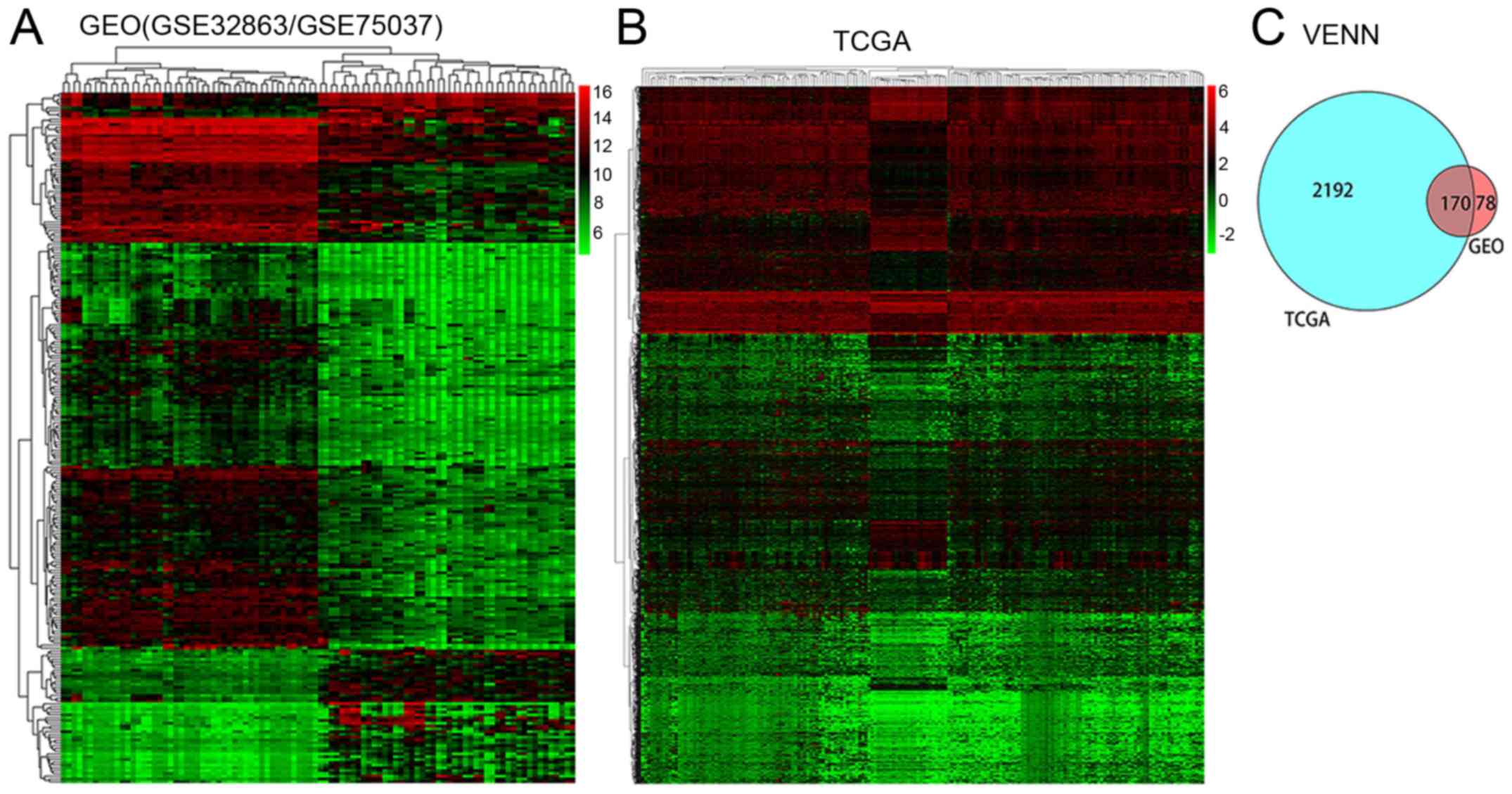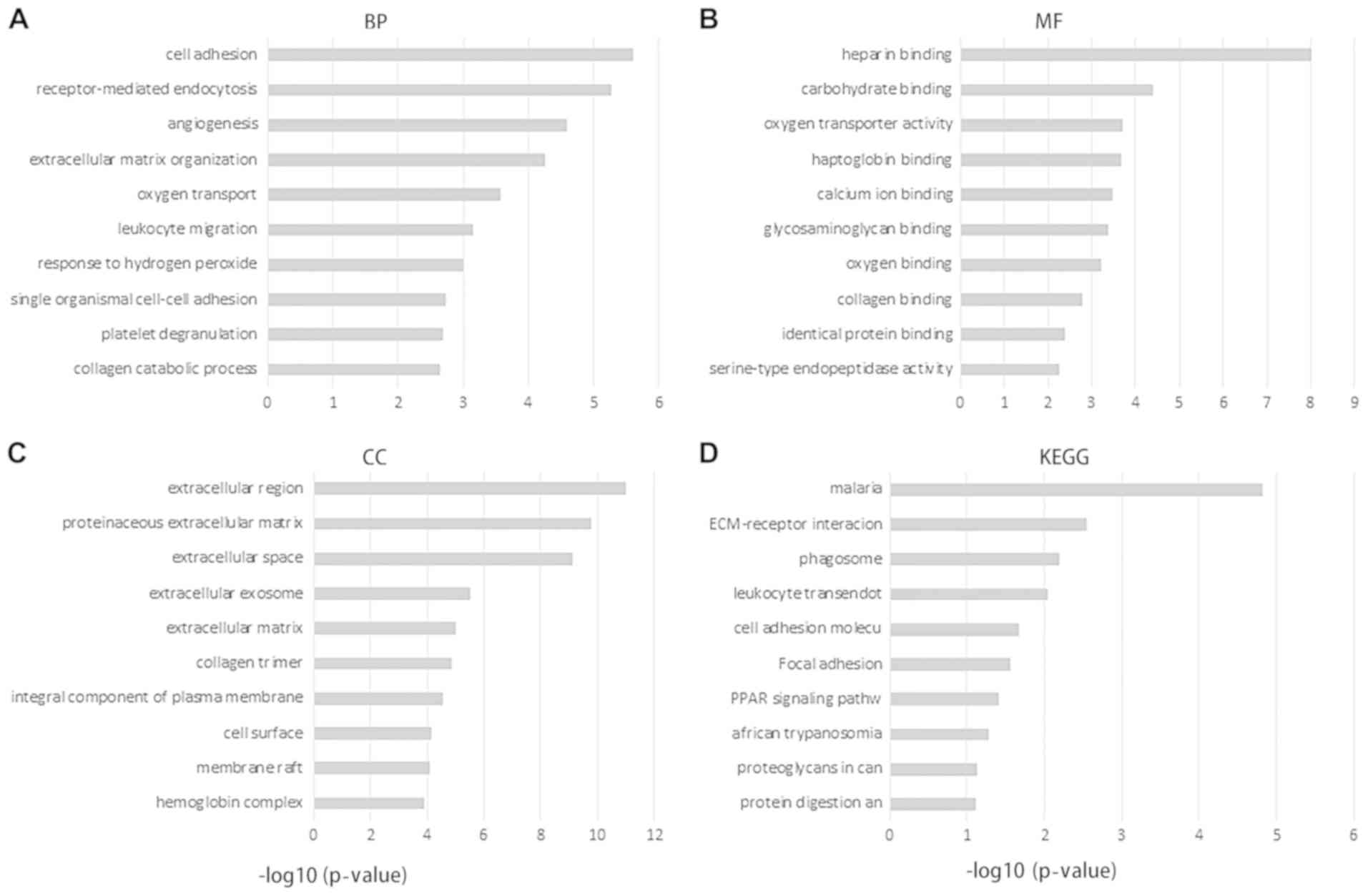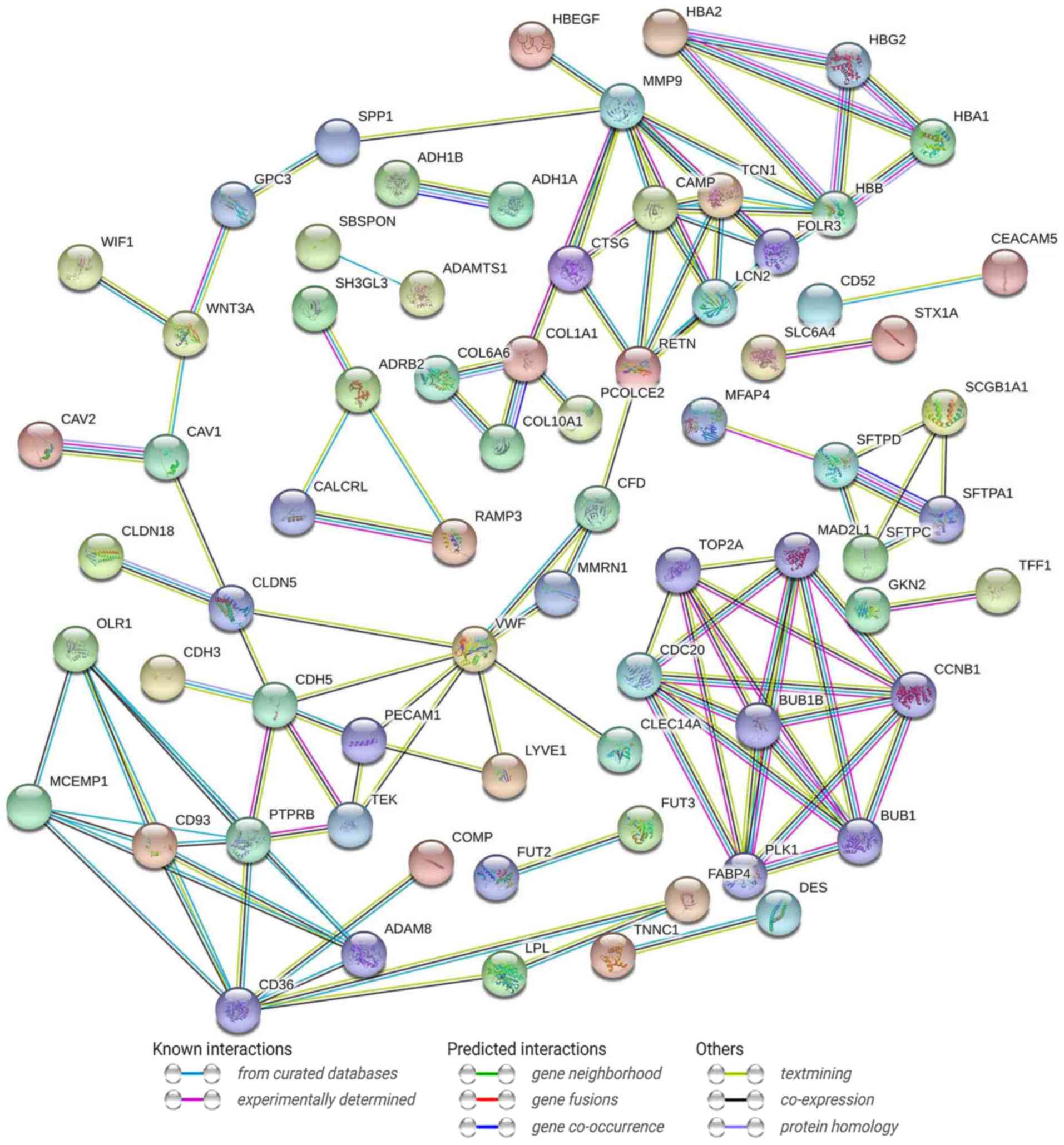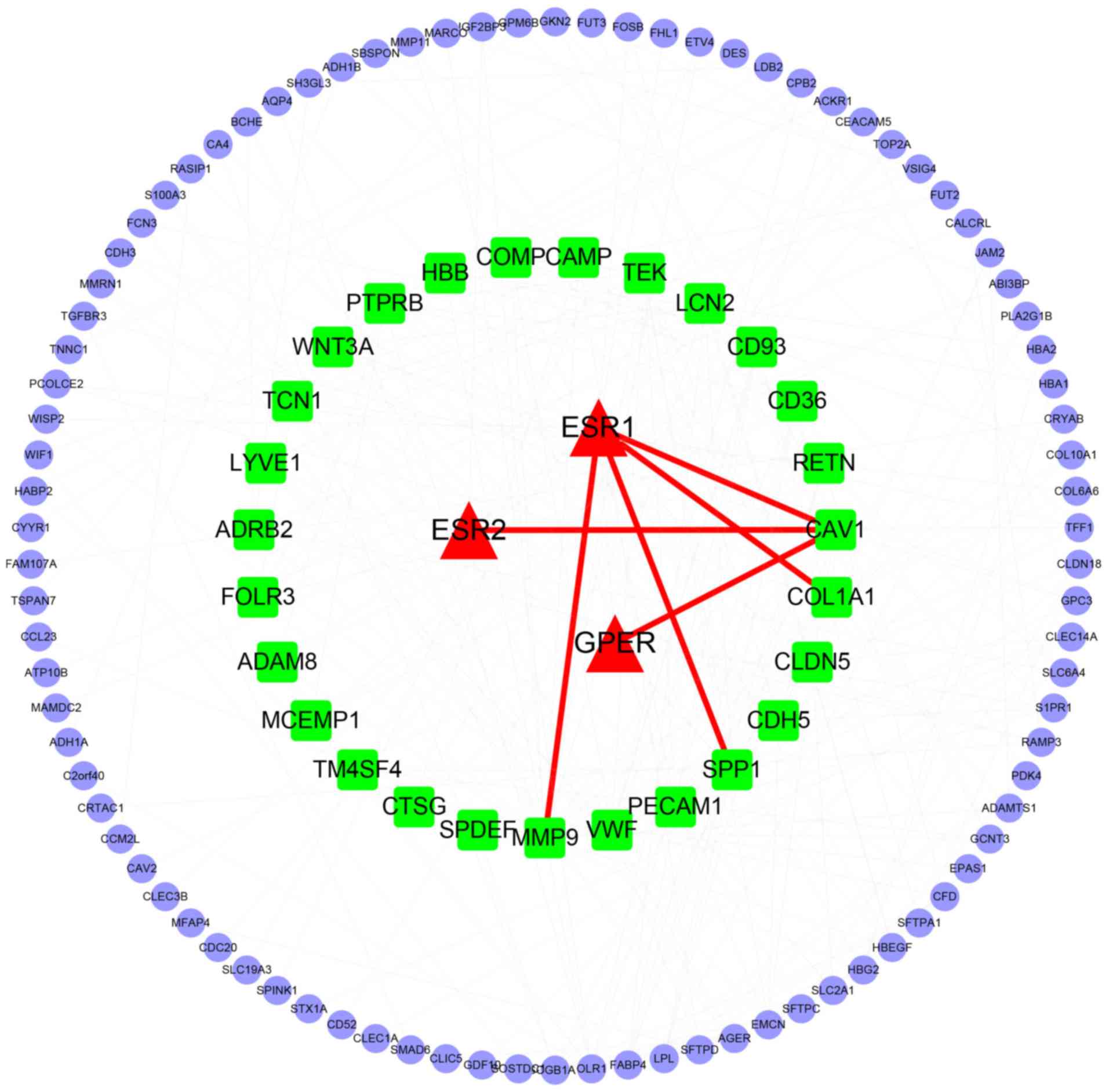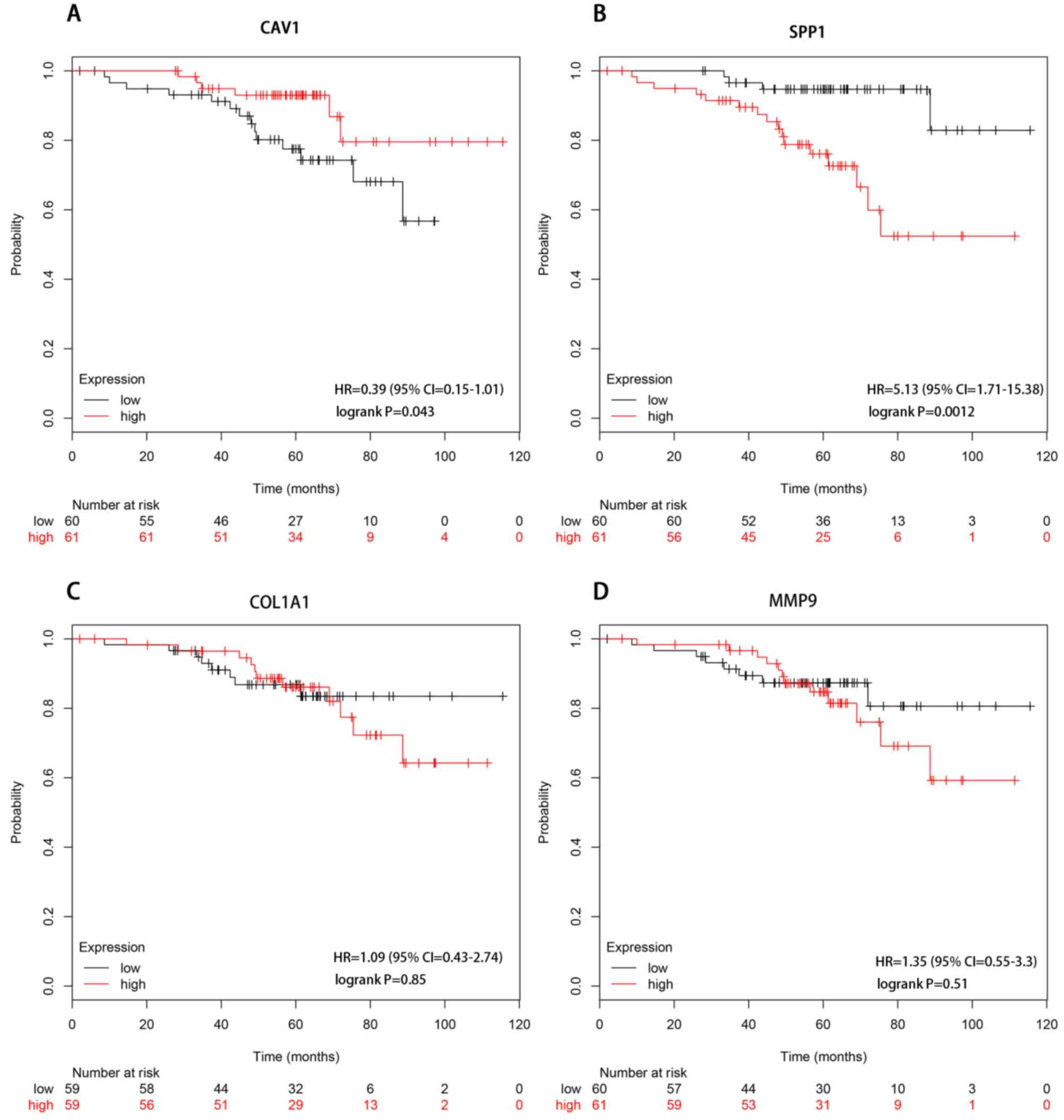|
1
|
Torre LA, Siegel RL and Jemal A: Lung
cancer statistics. Adv Exp Med Biol. 893:1–19. 2016. View Article : Google Scholar : PubMed/NCBI
|
|
2
|
Pirker R and Filipits M: Adjuvant therapy
in patients with completely resected non-small-cell lung cancer:
Current status and perspectives. Clin Lung Cancer. 20:1–6. 2019.
View Article : Google Scholar : PubMed/NCBI
|
|
3
|
Saito S, Espinoza-Mercado F, Liu H, Sata
N, Cui X and Soukiasian HJ: Current status of research and
treatment for non-small cell lung cancer in never-smoking females.
Cancer Biol Ther. 18:359–368. 2017. View Article : Google Scholar : PubMed/NCBI
|
|
4
|
Pikor LA, Ramnarine VR, Lam S and Lam WL:
Genetic alterations defining NSCLC subtypes and their therapeutic
implications. Lung Cancer. 82:179–189. 2013. View Article : Google Scholar : PubMed/NCBI
|
|
5
|
Shi K, Li N, Yang M and Li W:
Identification of key genes and pathways in female lung cancer
patients who never smoked by a bioinformatics analysis. J Cancer.
10:51–60. 2019. View Article : Google Scholar : PubMed/NCBI
|
|
6
|
Mollerup S, Jorgensen K, Berge G and
Haugen A: Expression of estrogen receptors alpha and beta in human
lung tissue and cell lines. Lung Cancer. 37:153–159. 2002.
View Article : Google Scholar : PubMed/NCBI
|
|
7
|
Tang H, Bai Y, Xiong L, Zhang L, Wei Y,
Zhu M, Wu X, Long D, Yang J, Yu L, et al: Interaction of estrogen
receptor β5 and interleukin 6 receptor in the progression of
non-small cell lung cancer. J Cell Biochem. 2018.(Epub ahead of
print).
|
|
8
|
Chen W, Xin B, Pang H, Han L, Shen W, Zhao
Z, Duan L, Cao P, Liu L and Zhang H: Downregulation of estrogen
receptor β inhibits lung adenocarcinoma cell growth. Oncol Rep.
41:2967–2974. 2019.PubMed/NCBI
|
|
9
|
Huang Q, Zhang Z, Liao Y, Liu C, Fan S,
Wei X, Ai B and Xiong J: 17β-estradiol upregulates IL6 expression
through the ERβ pathway to promote lung adenocarcinoma progression.
J Exp Clin Cancer Res. 37:1332018. View Article : Google Scholar : PubMed/NCBI
|
|
10
|
Donner I, Katainen R, Sipila LJ, Aavikko
M, Pukkala E and Aaltonen LA: Germline mutations in young
non-smoking women with lung adenocarcinoma. Lung Cancer. 122:76–82.
2018. View Article : Google Scholar : PubMed/NCBI
|
|
11
|
Lindeman NI, Cagle PT, Beasley MB, Chitale
DA, Dacic S, Giaccone G, Jenkins RB, Kwiatkowski DJ, Saldivar JS,
Squire J, et al: Molecular testing guideline for selection of lung
cancer patients for EGFR and ALK tyrosine kinase inhibitors:
Guideline from the college of American pathologists, international
association for the study of lung cancer, and association for
molecular pathology. J Thorac Oncol. 8:823–859. 2013. View Article : Google Scholar : PubMed/NCBI
|
|
12
|
Lee K, Jung HA, Sun JM, Lee SH, Ahn JS,
Park K and Ahn MJ: Clinical characteristics and outcomes of
non-small cell lung cancer patients with HER2 alterations in korea.
Cancer Res Treat. 2019.(Epub ahead of print). View Article : Google Scholar
|
|
13
|
Ranhotra HS: Estrogen-related receptor
alpha and cancer: Axis of evil. J Recept Signal Transduct Res.
35:505–508. 2015. View Article : Google Scholar : PubMed/NCBI
|
|
14
|
Selamat SA, Chung BS, Girard L, Zhang W,
Zhang Y, Campan M, Siegmund KD, Koss MN, Hagen JA, Lam WL, et al:
Genome-scale analysis of DNA methylation in lung adenocarcinoma and
integration with mRNA expression. Genome Res. 22:1197–1211. 2012.
View Article : Google Scholar : PubMed/NCBI
|
|
15
|
Girard L, Rodriguez-Canales J, Behrens C,
Thompson DM, Botros IW, Tang H, Xie Y, Rekhtman N, Travis WD,
Wistuba II, et al: An expression signature as an aid to the
histologic classification of non-small cell lung cancer. Clin
Cancer Res. 22:4880–4889. 2016. View Article : Google Scholar : PubMed/NCBI
|
|
16
|
Győrffy B, Surowiak P, Budczies J and
Lanczky A: Online survival analysis software to assess the
prognostic value of biomarkers using transcriptomic data in
non-small-cell lung cancer. PLoS One. 8:e822412013. View Article : Google Scholar : PubMed/NCBI
|
|
17
|
Yu W, Ding J, He M, Chen Y, Wang R, Han Z,
Xing EZ, Zhang C and Yeh S: Estrogen receptor β promotes the
vasculogenic mimicry (VM) and cell invasion via altering the
lncRNA-MALAT1/miR-145-5p/NEDD9 signals in lung cancer. Oncogene.
38:1225–1238. 2019. View Article : Google Scholar : PubMed/NCBI
|
|
18
|
Fu S, Liu C, Huang Q, Fan S, Tang H, Fu X,
Ai B, Liao Y and Chu Q: Estrogen receptor β1 activation accelerates
resistance to epidermal growth factor receptor-tyrosine kinase
inhibitors in non-small cell lung cancer. Oncol Rep. 39:1313–1321.
2018.PubMed/NCBI
|
|
19
|
Lund-Iversen M, Scott H, Strøm EH, Theiss
N, Brustugun OT and Grønberg BH: Expression of estrogen
receptor-alpha and survival in advanced-stage non-small cell lung
cancer. Anticancer Res. 38:2261–2269. 2018.PubMed/NCBI
|
|
20
|
Kuo LC, Cheng LC, Lee CH, Lin CJ, Chen PY
and Li LA: Estrogen and cigarette sidestream smoke particulate
matter exhibit ERα-dependent tumor-promoting effects in lung
adenocarcinoma cells. Am J Physiol Lung Cell Mol Physiol.
313:L477–L490. 2017. View Article : Google Scholar : PubMed/NCBI
|
|
21
|
Chen KY, Hsiao CF, Chang GC, Tsai YH, Su
WC, Chen YM, Huang MS, Tsai FY, Jiang SS, Chang IS, et al: Estrogen
receptor gene polymorphisms and lung adenocarcinoma risk in
never-smoking women. J Thorac Oncol. 10:1413–1420. 2015. View Article : Google Scholar : PubMed/NCBI
|
|
22
|
Ketteler J and Klein D: Caveolin-1, cancer
and therapy resistance. Int J Cancer. 143:2092–2104. 2018.
View Article : Google Scholar : PubMed/NCBI
|
|
23
|
Senetta R, Stella G, Pozzi E, Sturli N,
Massi D and Cassoni P: Caveolin-1 as a promoter of tumour
spreading: When, how, where and why. J Cell Mol Med. 17:325–336.
2013. View Article : Google Scholar : PubMed/NCBI
|
|
24
|
Ramírez CM, González M, Díaz M, Alonso R,
Ferrer I, Santpere G, Puig B, Meyer G and Marin R: VDAC and ERalpha
interaction in caveolae from human cortex is altered in Alzheimer's
disease. Mol Cell Neurosci. 42:172–183. 2009. View Article : Google Scholar : PubMed/NCBI
|
|
25
|
Watson CS, Jeng YJ, Hu G, Wozniak A,
Bulayeva N and Guptarak J: Estrogen- and xenoestrogen-induced ERK
signaling in pituitary tumor cells involves estrogen receptor-α
interactions with G protein-αi and caveolin I. Steroids.
77:424–432. 2012. View Article : Google Scholar : PubMed/NCBI
|
|
26
|
Perez White B, Molloy ME, Zhao H, Zhang Y
and Tonetti DA: Extranuclear ERα is associated with regression of
T47D PKCα-overexpressing, tamoxifen-resistant breast cancer. Mol
Cancer. 12:342013. View Article : Google Scholar : PubMed/NCBI
|
|
27
|
Zhang X, Zhang L, Tan X, Lin Y, Han X,
Wang H, Ming H, Li Q, Liu K and Feng G: Systematic analysis of
genes involved in oral cancer metastasis to lymph nodes. Cell Mol
Biol Lett. 23:532018. View Article : Google Scholar : PubMed/NCBI
|
|
28
|
Icer MA and Gezmen-Karadag M: The multiple
functions and mechanisms of osteopontin. Clin Biochem. 59:17–24.
2018. View Article : Google Scholar : PubMed/NCBI
|
|
29
|
Mountzios G, Ramfidis V, Terpos E and
Syrigos KN: Prognostic significance of bone markers in patients
with lung cancer metastatic to the skeleton: A review of published
data. Clin Lung Cancer. 12:341–349. 2011. View Article : Google Scholar : PubMed/NCBI
|
|
30
|
Wei R, Wong JPC and Kwok HF: Osteopontin-a
promising biomarker for cancer therapy. J Cancer. 8:2173–2183.
2017. View Article : Google Scholar : PubMed/NCBI
|
|
31
|
Ouyang X, Huang Y, Jin X, Zhao W, Hu T, Wu
F and Huang J: Osteopontin promotes cancer cell drug resistance,
invasion, and lactate production and is associated with poor
outcome of patients with advanced non-small-cell lung cancer.
OncoTargets Ther. 11:5933–5941. 2018. View Article : Google Scholar
|
|
32
|
Wang Y, Yang J, Liu H, Bi JR, Liu Y, Chen
YY, Cao JY and Lu YJ: The association between osteopontin and
survival in non-small-cell lung cancer patients: A meta-analysis of
13 cohorts. OncoTargets Ther. 8:3513–3521. 2015.
|
|
33
|
Moirangthem A, Bondhopadhyay B, Mukherjee
M, Bandyopadhyay A, Mukherjee N, Konar K, Bhattacharya S and Basu
A: Simultaneous knockdown of uPA and MMP9 can reduce breast cancer
progression by increasing cell-cell adhesion and modulating EMT
genes. Sci Rep. 6:219032016. View Article : Google Scholar : PubMed/NCBI
|
|
34
|
Piperigkou Z, Franchi M, Götte M and
Karamanos NK: Estrogen receptor beta as epigenetic mediator of
miR-10b and miR-145 in mammary cancer. Matrix Biol. 64:94–111.
2017. View Article : Google Scholar : PubMed/NCBI
|
|
35
|
Zhang Z, Fang C, Wang Y, Zhang J, Yu J,
Zhang Y, Wang X and Zhong J: COL1A1: A potential therapeutic target
for colorectal cancer expressing wild-type or mutant KRAS. Int J
Oncol. 53:1869–1880. 2018.PubMed/NCBI
|
|
36
|
Elkin M, Miao HQ, Nagler A, Aingorn E,
Reich R, Hemo I, Dou HL, Pines M and Vlodavsky I: Halofuginone: A
potent inhibitor of critical steps in angiogenesis progression.
FASEB J. 14:2477–2485. 2000. View Article : Google Scholar : PubMed/NCBI
|















